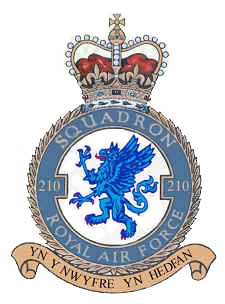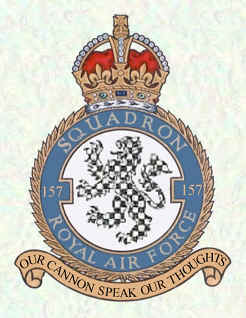
No. 206 Squadron is a Test and Evaluation Squadron of the Royal Air Force. Until 2005 it was employed in the maritime patrol role with the Nimrod MR.2 at RAF Kinloss, Moray. It was announced in December 2004 that 206 Squadron would disband on 1 April 2005, with half of its crews being redistributed to Nos. 120 and 201 Squadrons, also stationed at Kinloss. This was a part of the UK Defence Review called Delivering Security in a Changing World; the Nimrod MR.2 fleet was reduced in number from 21 to 16 as a consequence.

No. 201 Squadron of the Royal Air Force, until March 2010, operated the Nimrod MR2, based at RAF Kinloss, Moray. It is the only squadron affiliated with Guernsey, in the Channel Islands. This affiliation started in 1935 and is commemorated in the museum on Castle Cornet. Its history goes even further back than the RAF itself, being formed originally as No. 1 Squadron RNAS on 17 Oct 1914. The squadron will stand up again in 2021 as the second squadron equipped with the P-8A Poseidon anti-submarine warfare (ASW) aircraft.

No. 230 Squadron is an RAF squadron, currently based at RAF Benson. The squadron was part of Royal Air Force Germany, operating the Puma HC.1 there from 1980. Following the drawdown at the end of the Cold War, the squadron disbanded on 30 April 1992. This was short-lived however and the squadron reformed at RAF Aldergrove on 4 May 1992, again with the Puma HC.1.

No. 461 Squadron was a Royal Australian Air Force maritime patrol squadron during World War II which operated under Royal Air Force control flying in Europe and over the Atlantic. The squadron was formed in 1942 and was disbanded in mid-1945, just after the end of the war in Europe. Personnel were drawn from many countries of the British Empire, although the majority were Australians. Throughout the war, the squadron was credited with destroying a total of six German U-boats, and operated mainly in the Bay of Biscay and Atlantic.

No. 190 Squadron was a Royal Air Force squadron with a relatively short existence, but a very broad career. It served as a trainer squadron during the first World War and as convoy escort, airborne support and transport squadron during World War II.
No. 598 Squadron RAF was an Anti-aircraft Co-operation squadron of the Royal Air Force during the Second World War.

Number 207 Squadron is an historic bomber squadron and, latterly, a communications and flying training squadron of the Royal Air Force. It was announced on 5 July 2017 that No. 207 Squadron will again reform to become the Operational Conversion Unit for the UK F-35B Lightning Force and will return to RAF Marham in Norfolk where it was last based in 1965. No. 207 Squadron arrived at RAF Marham with six F-35Bs on 16 July 2019 before officially standing up on 1 August.

No. 210 Squadron was a Royal Air Force unit established in World War I. Disbanded and reformed a number of times in the ensuing years, it operated as a fighter squadron during World War I and as a maritime patrol squadron during the Spanish Civil War, World War II and the Cold War before it was last deactivated in 1971.
No. 228 Squadron RAF was a squadron of the Royal Air Force active at various times between 1918 and 1964. It spent the greatest part of its existence flying over water, doing so in First, and Second World Wars and beyond, performing anti-submarine, reconnaissance and air-sea rescue tasks.
No. 169 Squadron RAF was a tactical reconnaissance and later a night intruder squadron of the Royal Air Force during World War II.
No. 521 Squadron of the Royal Air Force was a Second World War meteorological observation unit operating from Norfolk.
No. 502 (Ulster) Squadron was a Royal Auxiliary Air Force squadron that saw service in World War II. It was reformed in September 2013, and is the oldest of all the reserve squadrons, being formed in 1925.
No 295 Squadron RAF was an airborne forces and transport squadron of the Royal Air Force during World War II. It was the first unit to be equipped with the Armstrong Whitworth Albemarle transport and glider tug aircraft.
No. 292 Squadron RAF was an air-sea rescue (ASR) squadron of the Royal Air Force operating in the Bay of Bengal during the Second World War.
No. 136 Squadron RAF was a short-lived RAF unit that saw no action in World War I, but upon reformation became the highest scoring unit in South East Asia Command during World War II. Shortly after the war the squadron was disbanded.
No. 296 Squadron RAF was an transport squadron of the Royal Air Force during the Second World War. With sister squadrons 295 and 297 it formed 38 Wing, which later expanded to create No. 38 Group RAF.
No. 577 Squadron was an anti-aircraft co-operation unit of the Royal Air Force formed during World War II and active from December 1943 till June 1946 in the defence of the Midlands.
No. 240 Squadron RAF was a Royal Air Force flying boat and seaplane squadron during World War I, World War II and up to 1959. It was then reformed as a strategic missile squadron, serving thus till 1963.

No 279 Squadron RAF was a Royal Air Force air-sea rescue squadron of World War II. The squadron was formed on 16 November 1941 and disbanded on 10 March 1946.

No. 157 Squadron RAF was a Royal Air Force Squadron active as a night fighter unit in the Second World War.









